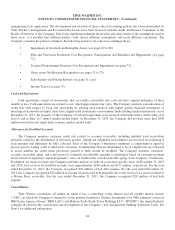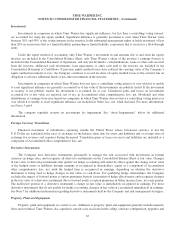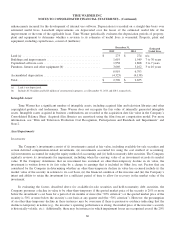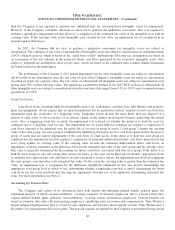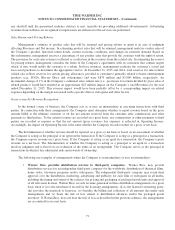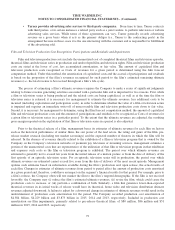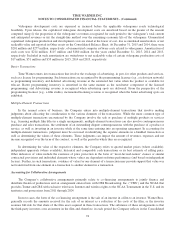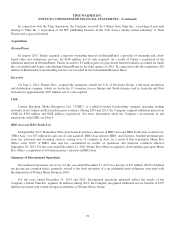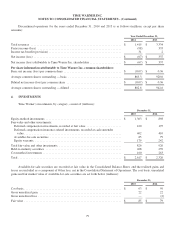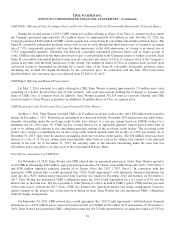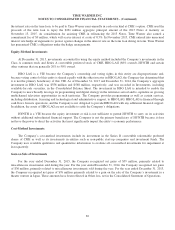Time Magazine 2015 Annual Report Download - page 86
Download and view the complete annual report
Please find page 86 of the 2015 Time Magazine annual report below. You can navigate through the pages in the report by either clicking on the pages listed below, or by using the keyword search tool below to find specific information within the annual report.TIME WARNER INC.
NOTES TO CONSOLIDATED FINANCIAL STATEMENTS - (Continued)
•Turner provides advertising sales services to third-party companies. From time to time, Turner contracts
with third parties, or in certain instances a related party such as a joint venture, to perform television or website
advertising sales services. While terms of these agreements can vary, Turner generally records advertising
revenue on a gross basis when it acts as the primary obligor (i.e., Turner is the contracting party) in the
arrangement because in those cases it is the one interacting with the customer and is responsible for fulfillment
of the advertising sold.
Film and Television Production Cost Recognition, Participations and Residuals and Impairments
Film and television production costs include the unamortized cost of completed theatrical films and television episodes,
theatrical films and television series in production and undeveloped film and television rights. Film and television production
costs are stated at the lower of cost, less accumulated amortization, or fair value. The amount of capitalized film and
television production costs recognized as Costs of revenues for a given period is determined using the film forecast
computation method. Under this method, the amortization of capitalized costs and the accrual of participations and residuals
is based on the proportion of the film’s revenues recognized for such period to the film’s estimated remaining ultimate
revenues (i.e., the total revenue to be received throughout a film’s life cycle).
The process of estimating a film’s ultimate revenues requires the Company to make a series of significant judgments
relating to future revenue generating activities associated with a particular film and is important for two reasons. First, while
a film or television series is being produced and the related costs are being capitalized, as well as at the time the film or
television series is released, it is necessary for management to estimate the ultimate revenues, less additional costs to be
incurred (including exploitation and participation costs), in order to determine whether the value of a film or television series
is impaired and requires an immediate write-off of unrecoverable film and television production costs down to fair value.
Second, it is necessary for management to determine, using the film forecast computation method, the amount of capitalized
film and television production costs and the amount of participations and residuals to be recognized as Costs of revenues for
a given film or television series in a particular period. To the extent that the ultimate revenues are adjusted, the resulting
gross margin reported on the exploitation of that film or television series in a period is also adjusted.
Prior to the theatrical release of a film, management bases its estimates of ultimate revenues for each film on factors
such as the historical performance of similar films, the star power of the lead actors, the rating and genre of the film, pre-
release market research (including test market screenings) and the expected number of theaters in which the film will be
released. In the absence of revenues directly related to the exhibition of a film or television program that is owned by the
Company on the Company’s television networks or premium pay television or streaming services, management estimates a
portion of the unamortized costs that are representative of the utilization of that film or television program in that exhibition
and expenses such costs as the film or television program is exhibited. The period over which ultimate revenues are
estimated is generally not to exceed ten years from the initial release of a motion picture or from the date of delivery of the
first episode of an episodic television series. For an episodic television series still in production, the period over which
ultimate revenues are estimated cannot exceed five years from the date of delivery of the most recent episode. Management
updates such estimates based on information available during the film’s production and, upon release, the actual results of
each film. Changes in estimates of ultimate revenues from period to period affect the amount of production costs amortized
in a given period and, therefore, could have an impact on the segment’s financial results for that period. For example, prior to
a film’s release, the Company often will test market the film to the film’s targeted demographic. If the film is not received
favorably, the Company may (i) reduce the film’s estimated ultimate revenues, (ii) revise the film, which could cause the
production costs to increase, or (iii) perform a combination of both. Similarly, a film that generates lower-than-expected
theatrical revenues in its initial weeks of release would have its theatrical, home video and television distribution ultimate
revenues adjusted downward. A failure to adjust for a downward change in estimates of ultimate revenues would result in the
understatement of production costs amortization for the period. The Company recorded production cost amortization of
$4.384 billion, $4.229 billion and $3.873 billion in 2015, 2014 and 2013, respectively. Included in production cost
amortization are film impairments, primarily related to pre-release theatrical films, of $80 million, $86 million and $51
million in 2015, 2014 and 2013, respectively.
72




